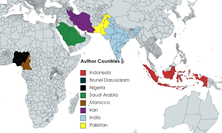Non-Body Contact Thermometer with Voice Output Via Wireless Communication
Abstract
Currently, thermometer has been widely used by the public. In general, thermometers are designed for people who have normal physical conditions, especially in the ability to see. Disabled people, especially blind people, will find it difficult to use the existing thermometer, especially with the current pandemic situation, which is likely to spread COVID-19 quickly. In connection with this problem, non-contact body temperature measurement is needed with sound output and a wireless system so that there is less possibility of exposure to disease. Therefore, this study describes a non-body contact thermometer with sound output via wireless. The purpose of this study concludes that Non-Body Contact Thermometers can be made with Voice Output Via Wireless to determine normal or hyper and hypo human body temperatures. Thus, this thermometer make it easier for those who have limitations to see and reduce exposure to covid-19 between patients and users. The method in this study employed MLX90614 as a sensor whose output is in the form of digital data, HC-SR04 as a trigger on the MLX90614 sensor, and DF player as a reader on data that have been recorded via Google and stored on the SD card, and XBEE module as transceivers of data to pc. Temperature testing was further conducted by comparing the module with a standard tool, that is a digital thermometer. The error obtained from the module at normal temperature is 0.98%, while the smallest error is 0.1%. Furthermore, in terms of the hypo temperature, the largest error is 1.80%, while the smallest error is 0.42%. Last, at hyper temperature, the largest error is 1.75%, while the smallest error is 0.10%.

This work is licensed under a Creative Commons Attribution-ShareAlike 4.0 International License.
Authors who publish with this journal agree to the following terms:
- Authors retain copyright and grant the journal right of first publication with the work simultaneously licensed under a Creative Commons Attribution License that allows others to share the work with an acknowledgement of the work's authorship and initial publication in this journal.
- Authors are able to enter into separate, additional contractual arrangements for the non-exclusive distribution of the journal's published version of the work (e.g., post it to an institutional repository or publish it in a book), with an acknowledgement of its initial publication in this journal.
- Authors are permitted and encouraged to post their work online (e.g., in institutional repositories or on their website) prior to and during the submission process, as it can lead to productive exchanges, as well as earlier and greater citation of published work (See The Effect of Open Access).











